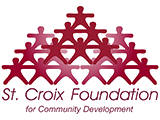Educators around the country and the world are racing to ‘crack the code’ and find the perfect recipe for reforming their underperforming educational systems. It’s a race against the clock that underpins state economies, global competition, and the viability of entire civilizations. The same is true for the Virgin Islands as policymakers and education stakeholders continue to analyze solutions to improve the Territory’s public school system.
For the past 10 ten years, St. Croix foundation has also sought to crack the code, exploring national models of educational excellence with one overarching mission: to advocate for and support innovative and sustainable strategies that will lead to rapid public education transformation. We have read about and personally witnessed groundbreaking programs both locally and abroad- ones we believe, if replicated with fidelity, could lead to radical improvements in our educational system.
But in order to get there, we have learned that what we do is much less important than the how we do it when building strong systems that best serve the needs of all our community’s youth. In our research, we have also seen that long and short term goals are more often met when reform plans are built on a solid foundation of collaboration—broad-based and community inclusive. For the Foundation, collaboration is really the fundamental “How” to the issue of education reform.
Sadly, collaboration is also the greatest challenge for most education reform efforts as far too many stakeholders haven’t fully mastered the art of working together. Thankfully, there are many models of collaboration for us to examine and model our reform efforts after, some of which we think are particularly noteworthy and could help the VI find solutions:
RACE TO THE TOP: In 2009, Barack Obama and Secretary of Education Arne Duncan launched Race to the Top (RTTT), and radically changed America’s educational reform landscape. As the largest competitive granting program in the history of American public education, RTTT awarded $4.35 billion through the U.S. Department of Education (USDOE) to spur K-12 education reform. While the Territory was not eligible to participate in RTTT (Puerto Rico was), one criteria for applying was that states had to build broad collaboration into their strategies, which meant that major stakeholder groups had to sign off on each state’s reform plan. States that passed the first round of the application process had to submit video presentations demonstrating collaboration and alignment between stakeholders including unions, boards of education, departments of education, political parties, business leaders, charter operators, parent groups, and more.
In the end, Delaware and Tennessee were chosen by the USDOE as the first states to be awarded RTTT grants and there’s little doubt why. Both states took the challenge seriously and set a high standard for radical and rapid reform. We urge local stakeholders to review their RTTT video presentations, which can be found on the St. Croix Foundation’s Facebook page, to see what collaborative reform really looks like. It’s an inspiring demonstration of Leadership and Commitment – one that our education stakeholders can model.
VISION 2015: Delaware’s RTTT plan, “Vision 2015,” resulted in an award of $100 million and is a bold agenda designed to provide a world-class education to all public school students in Delaware. Developed by a coalition of education, government, business and civic leaders throughout Delaware, Vision 2015 established the following goals for the state’s reform agenda: 1. Setting High Standards and Developing a Common Curriculum; 2. Developing and Supporting High-Quality Teachers; 3. Empowering Principals to Lead their Schools and; 4. Establishing a Simple and Equitable Funding System.
L.A. COMPACT: Another reform model is the L.A. Compact, which is a city-wide plan signed by 18 major stakeholder groups in the Los Angeles Unified School District that has become a national model of collaboration and common visioning. The L.A. Compact established the following goals (among others) for its reform efforts; 1. Achieve High Quality Teaching and Learning In Classrooms; 2. Build Collaborative Leadership Capacity; 3. Streamline and Decentralize Operations; 4. Expand Innovative Practices that are Working; 5. Implement a New Accountability System and; 6. Provide Students Multiple Pathways for Workforce/Career Preparation.
Education reform is too big of a task for just one group to tackle. The whole village needs to be a part of the process, recognizing that our children are pouring out of our schools and onto our streets unprepared in the midst of a depressed economy and an unprecedented crime wave. In the words of Rahm Emmanuel (Obama’s former Chief of staff), we would be foolish “to let a good crisis go to waste.” This election season, let’s ask our political candidates how they intend to support collaborative efforts that serve our children and our schools.
This editorial is a part of the Foundation’s Education First series and will be published every Wednesday until election day. For more information, call 773.9898.
Resources:
Race to the Top Eligibility and Criteria for Funding
- Race to the Top Program Executive Summary, U.S. Department of Education, 2009
Race to the Top Video Presentations (2010)
- Delaware: Phase 1, Tier 2 Presentation (awarded $119 million federal grant funds)
- Tennessee: Phase 1, Tier 2 Presentation (awarded $501 million federal grant funds)
State Plans and Compacts
- Delaware’s Race to the Top Reform Plan:Vision 2015
- Los Angeles Unified School District’s Compact: A Collaboration to Transform Education in Los Angeles
